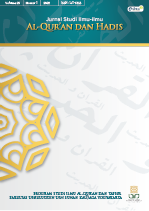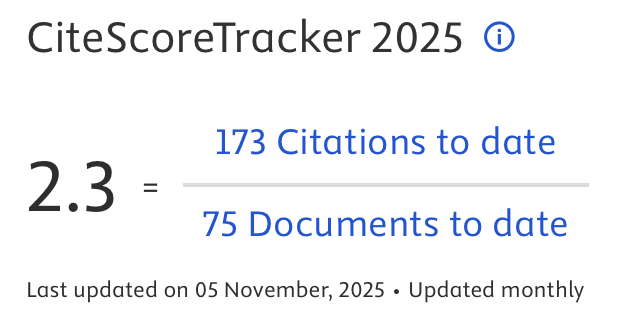Investigating Cohesiveness of QS. Al-Mā’idah: A Review on Michel Cuypers Implementation of Semitic Rhetorical Analysis (SRA)
DOI:
https://doi.org/10.14421/qh.2022.2301-03Keywords:
Cohesion, Cohesiveness, Cuypers, Semitic Rhetorical Analysis (SRA), QS. Al-Mā’idahAbstract
This article examines Michel Cuyper’s interpretation of the Qur’an which is the result of the application of Semitic Rhetorical Analysis (SRA) in QS. Al-Mā’idah. Although SRA’s implementation has demonstrated the coherence of the Qur’anic text; however, no one has properly articulated the cohesiveness of the Qur’anic text as the basis of that coherence. Thus, to ascertain the text’s cohesiveness in terms of positions and forms from the SRA’s perspective, this study applied cohesion text theories to Cuypers’ implementation of SRA in QS. Al-Mā’idah. A thesis of the paper is that, according to SRA, the cohesiveness of a qur’anic text in QS Al-Mā’idah can be shown through the pairings of words or sentences inside particular groupings of text particles following the principles of Semitic Rhetoric. The Semitic Rhetoric’s principle of parallel, concentric, or mirror symmetry in those text particle groups determined which words or phrases are paired in a text particle group. As a result, from an SRA perspective, the Qur’anic text’s cohesiveness may be discovered at each level of the text particle group, demonstrating multi-layered cohesiveness. In Cuypers’ reading of QS Al-Mā’idah, synonyms and repetition are used to maintain lexical cohesion, while ellipsis, substitution, and reference established grammatical cohesion. Abstract viewed: 782 times
|
Abstract viewed: 782 times
|
 PDF downloaded = 530 times
PDF downloaded = 530 times
References
Al-Qurṭubī. Al-Jāmi‘ Lī Aḥkām al-Qur’Ān. Vol. 6. Cairo: Dār al-Kutub al-Miṣriyyah, 1964.
Al-Tha’labī. Al-Kashf Wa al-Bayān ‘An Tafsīr al-Qur’Ān. Vol. 4. Beirut: Dār Iḥya’ al-Turāth al-‘Arabiy, 2002.
Al-Zamakhsharī. Al-Kashshāf. Vol. 1. Beirut: Dār al-Kitāb al-’Arabī, 1407.
Asnawi, Aqdi Rofiq. “Penerapan Semitic Rhetorical Analysis (SRA) Pada Surah Al-Qiyamah.” Mutawatir 8, no. 1 (June 19, 2018): 143–169.
———. “Re-Analyzing the Structure of Surah al-‘Alaq Using Semitic Rhetorical Analysis (SRA): A Critical Study on Cuypers’ Methodology of Analyzing Qur’anic Structure.” QURANICA - International Journal of Quranic Research 13, no. 1 (June 30, 2021): 165–194.
Asnawi, Aqdi Rofiq, and Idri. “Examining Semitic Rhetoric: A Qur’anic Sciences Perspective.” Jurnal Ushuluddin 28, no. 2 (December 31, 2020): 127–139.
Attallah, Halla. “Michel Cuypers, The Composition of the Qurʾan: Rhetorical Analysis, translated by Jerry Ryan. London/New York: Bloomsbury Academic, 2015, ISBN 9784147227483 (hardcover).” Der Islam 95, no. 1 (March 22, 2018): 211–217.
Balḥūt, Syarīfah. “Al-Iḥālah: Dirāsah Naẓariyyah.” University of Aljazair, 2006.
Boisliveau, Anne-Sylvie. “Michel Cuypers, Le Festin: Une Lecture de La Sourate al-Mâ’ida.” Journal of Qur’anic Studies 9, no. 1 (April 1, 2007): 119–123.
Cuypers, Michel. Fī Naẓm al-Qur’ān. Translated by Adnane Mokrani and Ṭāriq Manzū. Beirut: Dār al-Mashriq, 2018.
———. “Semitic Rhetoric as a Key to the Question of the Naẓm of the Qur’anic Text.” Journal of Qur’anic Studies 13, no. 1 (April 2011): 1–24.
———. The Banquet: A Reading of the Fifth Sura of the Qur’an. Translated by Patricia Kelly. Miami: Convivium Press, 2008.
———. The Composition of the Qur’an. London: Bloomsbury Academic, 2015.
al-Ḍanāwī, Sa‘dī, and Jūzīf Mālik. Mu‘jam al-Mutarādifāt Wa al-Aḍdād. Lebanon: al-Muassasah al-Ḥadīthiyyah Lī al-Kitāb, 2013.
Dinkler, Michal Beth. “Influence: On Rhetoric and Biblical Interpretation.” Brill Research Perspectives in Biblical Interpretation 4, no. 3 (2021).
Grisot, Cristina. Cohesion, Coherence and Temporal Reference from an Experimental Corpus Pragmatics Perspective. New York: Springer, 2018.
Haleem, M.A.S. Abdel, ed. The Qurʼan: A New Translation. Oxford World’s Classics. New York: Oxford University Press, 2005.
Halliday, M.A.K., and Ruqaiya Hasan. Cohesion in English. London: Longman, 1976.
Ḥawwā, Sa‘īd. Al-Asās Fī al-Tafsīr. Vol. 3. Cairo: Dār al-Salām, 1424.
Ibn ‘Āshūr. Al-Taḥrīr Wa al-Tanwīr. Vol. 6. Tunis: al-Dār al-Tūnisiyyah lī al-Nashr, 1984.
Ibn ‘Aṭiyyah. Al-Muḥarrar al-Wajīz Fī Tafsīr al-Kitāb al-‘Aziz. Vol. 2. Beirut: Dār al-Kutub al-‘Ilmiyyah, 1984.
Ibn Kathīr. Tafsīr Al-Qur’ān al-‘Aẓīm. Vol. 3. Beirut: Dār al-Kutub al-‘Ilmiyyah, 1419.
Joosten, Jan. “Biblical Rhetoric as Illustrated by Judah’s Speech in Genesis 44.18-34.” Journal for the Study of the Old Testament 41, no. 1 (2016).
Keller, Jonathan. “Ambiguities of Prophecy: Old Testament Rhetoric in the American Founding Era.” Politics and Religion, 2020.
Kerremans, Koen. “Applying Computer-Assisted Coreferential Analysis to a Study of Terminological Variation in Multilingual Parallel Corpora.” In New Perspectives on Cohesion and Coherence: Implications for Translation, edited by Katrin Menzel, Ekaterina Lapshinova-Koltunski, and Kerstin Anna Kunz, 49–75. Berlin: Language Science Press, 2017.
Meynet, Roland. Treatise on Biblical Rhetoric. Translated by Leo Arnold. Leiden and Boston: Brill, 2012.
Meynet, Roland, Louis Pouzet, Naïla Farouki, and Ahyaf Sinno. Ṭarīqah Al-Taḥlīl al-Balāghī Wa al-Tafsīr. Translated by Jarjawrah Ḥardān and Hanrī ‘Uways. Beirut: Dār al-Mashriq, 2004.
Mokrani, Adnane. “Semitic Rhetoric and the Qur’ān: The Scholarship of Michel Cuypers.” In New Trends in Qur’anic Studies: Text, Context, and Interpretation, by Mun’im Sirry, 61–81. Atlanta, Georgia: Lockwood Press, 2019.
al-Qaṭṭān, Mannā‘. Mabāḥith Fī ‘Ulūm al-Qur’Ān. Cairo: Maktabah Wahbah, n.d.
al-Rāzī, Fakhr al-Dīn. Mafātiḥ Al-Ghayb. Vol. 11. Beirut: Dār Iḥyā’ al-Turāth al-‘Arabiy, 1420.
Robinson, Neal. “Hands Outstretched: Towards a Re-Reading of Sūrat al-Māʾida.” Journal of Qur’anic Studies 3, no. 1 (2001): 1–19.
Shah, Mustafa, and Muhammad Abdel Haleem, eds. “List of Contributors.” In The Oxford Handbook of Qur’anic Studies. Oxford: Oxford University Press, 2020.
Sinai, Nicolai. “Review Essay: ‘Going Round in Circles’: Michel Cuypers, The Composition of the Qur’an: Rhetorical Analysis, and Raymond Farrin, Structure and Qur’anic Interpretation: A Study of Symmetry and Coherence in Islam’s Holy Text.” Journal of Qur’anic Studies 19, no. 2 (June 2017): 106–122.
Sumarlam. Teori Dan Praktik Analisis Wacana. Surakarta: Pustaka Cakra, 2003.
al-Ṭabarī, Ibn Jarīr. Jāmi‘ al-Bayān ‘An Ta’Wīl Āy al-Qur’Ān. Vol. 8. Cairo: Dār al-Hijr, 2001.
Villano, Raoul, and Giuliano Lancioni. “Qurʾanic Pairs and Semitic Rhetoric.” In Studi Del Sesto Convegno RBS, 2021.
Watts, James W. “Biblical Rhetoric of Separatism and Universalism and Its Intolerant Consequences.” Religions 11, no. 4 (2020).
Zaimar, Okke Kusuma Sumantri, and Ayu Basoeki Harahap. Telaah Wacana. Jakarta: The Intercultural Institute, 2009.
“Michel Cuypers.” Fondazione Internazionale Oasis. Accessed October 7, 2021. http://www.oasiscenter.eu/en/michel-cuypers.
“Michel Cuypers, P.F.J. – Dominican Institute for Oriental Studies,” n.d. Accessed October 7, 2021. https://www.ideo-cairo.org/en/michel-cuypers-p-f-j-2/.
Downloads
Published
How to Cite
Issue
Section
License
Publishing your paper with Jurnal Studi Ilmu-ilmu al-Qur'an dan Hadis means that the author or authors retain the copyright in the paper. Jurnal Studi Ilmu-ilmu al-Qur'an dan Hadis uses license CC-BY-NC-ND or an equivalent license as the optimal license for the publication, distribution, use, and reuse of scholarly works. This license permits anyone to copy and redistribute the material in any medium or format and must give appropriate credit, provide a link to the license, and indicate if changes were made. If you remix, translate, transform or build upon the material you may use it for private use only and not for distribution. Jurnal Studi Ilmu-ilmu al-Qur'an dan Hadis granted an exclusive non-commercial reuse license by the author(s), but the author(s) are able to put the paper onto a website, distribute it to colleagues, give it to students, use it in your thesis, etc, so long as the use is not directed at a commercial advantage or toward private monetary gain. The author(s) can reuse the figures and tables and other information contained in their paper published by Jurnal Studi Ilmu-ilmu al-Qur'an dan Hadis in future papers or work without having to ask anyone for permission, provided that the figures, tables, or other information that is included in the new paper or work properly references the published paper as the source of the figures, tables or other information, and the new paper or work is not direct at a private monetary gain or commercial advantage.
Jurnal Studi Ilmu-ilmu al-Qur'an dan Hadis journal Open Acces articles are distrubuted under the Creative Commons Attribution-NonCommercial-NoDerivatives 4.0 International (CC BY-NC-ND 4.0). Article can be read, copy and redistribute the material ini any medium or format under the following conditions:
Attribution — You must give appropriate credit, provide a link to the license, and indicate if changes were made. You may do so in any reasonable manner, but not in any way that suggests the licensor endorses you or your use.
NonCommercial — You may not use the material for commercial purposes.
NoDerivatives — If you remix, transform, or build upon the material, you may not distribute the modified material.










